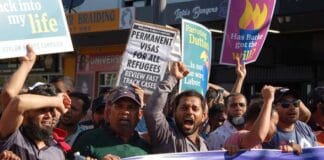Scores of Hazara refugee applications are being rejected because of Australian government claims that one or other part of Afghanistan is safe. One Hazara asylum seeker was recently deported to Pakistan. But Hazaras face constant danger, persecution and fear of mass killings in both Afghanistan and Pakistan.
A doctor in Quetta reported to Al Jazeera in October that, “People are scared to even go to the other town for funerals. And when they go out, they make sure it’s not a Hazara bus they travel in. They recite their prayers, not knowing whether they will make it.”
Since 2003 nearly 500 Hazaras have been killed and over 1500 injured as a result of targeted killing in Pakistan.
On October 4, 13 Hazaras on a bus in Quetta were brutally executed. Ironically, on September 3, 42 Hazaras were gunned down in a Quetta square overlooked by an Australian immigration propaganda poster warning of the dangers of getting a boat to Australia.
In August 2010, 18 Hazaras were killed by Afghan police in Kabul.
In late June 2010, Reuters newsagency reported that the bodies of 11 men, with their heads cut had been found in Oruzgan.
On June 3, 2011, Jawad Zahak, the head of Bamiyan Provincial Council and was kidnapped and killed on his way from Kabul to Bamiyan in Ghorband. The killers, alleged members of Hizb-e Islami, have significant numbers in the Afghan parliament and government. For the past five years the Bamiyan road to Kabul through Wardak was essentially closed because the “Taliban” kill anybody who looked like a Hazara.
Even the US State Department says that “no part of Afghanistan should be considered immune from violence” and that the “security environment remains volatile and unpredictable”.
Earlier this year, The Age reported that up to 20 of the 179 asylum seekers returned to Afghanistan after the 2001 Tampa controversy had been killed by the Taliban.
In January, 73 organisations in Australia condemned the MOU, a deportation agreement between the Afghan and Australian governments.
By Ian Rintoul





